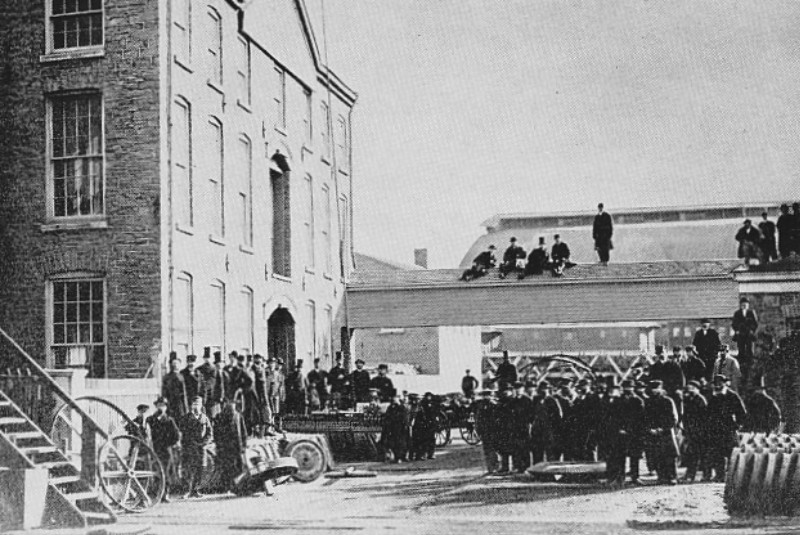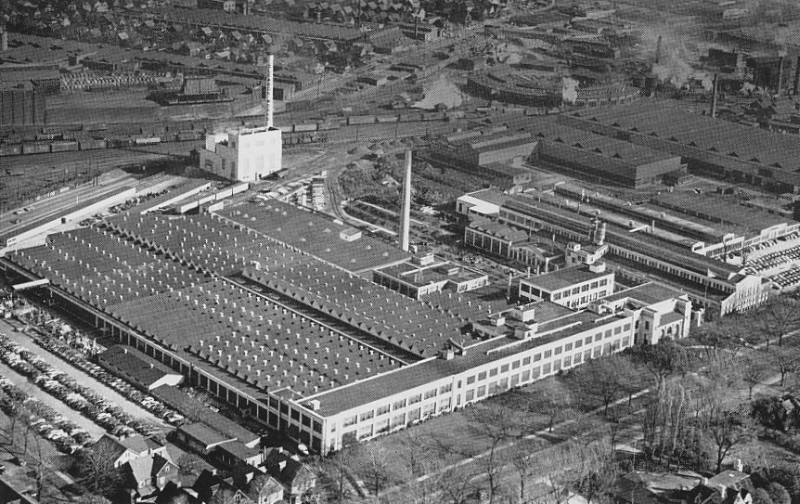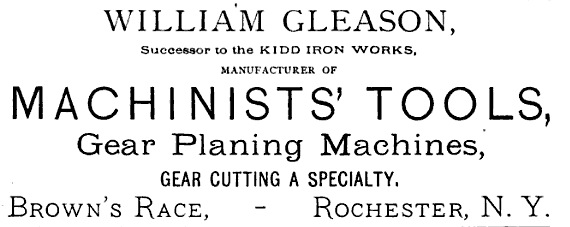 |
|
 |
| 1890 Gleason Works Factory View, Brown's Race |
|
1950 Gleason Works Factory View, 1000 University Avenue |
William Gleason was born in 1836 in Ireland. In 1855 he, along with his mother and brother, came to the US and settled in Rochester, NY. William got married and had two children, and was living in Chicago with his young family, when in 1859 His wife and year-old daughter died. Gleason and his 3-year-old son, Thomas F., moved back to Rochester. William remarried and for the duration of the Civil War operated a lathe. Gleason proved to have a talent for machine shop work.
In 1864 Gleason co-founded woodworking and metalworking machinery manufacturer Connell, Gleason & Graham. In the early 1870s, following some sort of disagreement with his partners, Gleason left and purchased an interest in Rochester machine-tool maker Kidd Iron Works; William Kidd remained president and controlling owner. Gleason became superintendent of the factory until 1876 when he bought out Kidd, and, about a year later, renamed the business to William Gleason
In 1888, the Genesee Foundry Co. was organized and in 1890 so was the Gleason Tool Co. In 1903 they were combined and became the Gleason Works. They continue to use the name Gleason Works, which is now a subsidiary of Gleason Corporation.
From the time he assumed control of the Kidd Iron Works, Gleason’s focus was on gear cutting machines. From Kidd he inherited a product lineup that included engine lathes, planers, and drilling machines. An 1889 fire destroyed machinery patterns, and the lathe designs, at least, were modernized when new patterns were made. In 1900 the lathe and planer product lines were sold to the Pittsburg Machine Tool Co. Over a century later, the Gleason Works's focus remains on machinery for manufacturing gears.
William Gleason's children were important to the success of the business. By 1877 eldest son Tom was active in business and was the heir apparent. The three younger children, Catherine Anselm (Kate) Gleason (born 1865), James Emmett Gleason (1869) and Andrew Chace Gleason (1873), would also be heavily involved.
In 1877 Tom died at age 20, and the business rapidly fell into crisis. Kate, only 11 years old, assisted her father on the business side, becoming a company bookkeeper at age 14. Kate went on to study mechanical engineering at Cornell, the only woman in her class. To her great regret she was forced to drop out before finishing as her father's business was again in crisis. She increasingly took over the running of the office side of the business.
Her brothers also would join the business, at first primarily focused on the shop rather than the office. Both brothers would also study mechanical engineering, with James, with James, like his sister, having to drop out to support the family business. The two brothers both became skilled machine designers. Kate, meanwhile, became company secretary and treasurer, and played an active role in sales, pushing the company to pursue international business.
Andrew apparently resented his sister's involvement in the business, particularly her flair for publicity and emphasis on customers rather than products. In 1913, with his brother's acquiescence, Andrew forced his sister out of the business. James would be president of the Gleason Corp. from his father's death in 1922 until 1947 and gave his sister credit for the company's early and continuing success in foreign markets.

From 1876 Rochester City Directory
Information Sources
- Gleason's website has history information, both on the parent company and their subsidiaries.
- Industrial Advance of Rochester 1884, pg. 152.
Rochester has many elaborately equipped workshops and manufactories, but none so extensive in this special line of production, as that of Mr. William Gleason, whose facilities surpass those of any other house of the kind in the city. These machine works were founded in 1836 and for many years were known as the Kidd Iron Works. After several changes in the firm, it passed into the hands of Mr. Gleason in 1874.
The works consist of a three-story building 70x160 feet in dimensions with a foundry in the rear, 60x85 which is fitted up with all modern machinery necessary for the manufacture of laths, planers, upright drills, boring machines, gear-dressing machines and general machinists' tools, the chief specialties of the house being iron planers and lathes and Gleason's patent gear-dressing machines, which enjoy an unquestioned reputation for durability, strength and efficiency.
The trade of this house extends throughout the United States, and the products are also exported to foreign countries. This extensive establishment is a feature through which the manufacturing industries of Rochester are greatly enhanced and which has been largely instrumental in building up the city's name as a producing center for improved and reliable machinery.
- 1903-01-15 The Iron Age, page 33.
The Gleason Works have incorporated with a capital stock of $225,000 for the manufacture of machine tools and gears. The directors are William Gleason, Kate Gleason, James E. Gleason, Andrew C. Gleason, Richard Marriott, Amos Walker and Ferdinand Schwab of Rochester, N. Y.
- 1950 book The Gleason Works, 1865-1950, pg. 9.
- 2010 book, The Life and Letters of Kate Gleason, Janis Gleason. We have not seen this book but a newspaper article (Rochester Business Journal, 2015-06-12, by Julie Kirkwood) quotes from it.
- 2022 book, Female Innovators Who Changed Our World: How Women Shaped STEM, by Emma Green (available, e.g., from Amazon), has a biography of Kate Gleason (1865-1933), daughter of William Gleason and a director of her father's company. It notes that in the early 1870s, after founding Connell, Gleason & Graham, " Due to a difference of [opinion] between himself and the other two partners, William Gleason went to work for Kidd Iron Works who manufactured machines—from lathes and upright drills to steam engines." Oldest brother (actually a half-brother) Tom died when Kate was 11, and Kate then appointed herself to be heir apparent to the business. She worked long hours for the business and became bookkeeper when she was only 14, helping to rescue the business from a financial crisis. She left the business for a time to study mechanical engineering at Cornell, the only woman in her class. She had to leave before finishing her degree as her father's business was again in financial difficulty. In the 1890s Kate was largely running the business side of the operation while her father and brothers, James and Andrew, designed and built the machines. Andrew was particularly against his sister having a prominent role in the business, and in 1913 Andrew, with James' acquiescence, forced Kate out of the business. She went to the Ingle Machining Co. where she help improve their business, was elected as a member of the ASME, developed concrete pouring techniques, and became president of the First National Bank of East Rochester.
- Kenneth Cope's American Lathe Builders 1810-1910, 2001, page 67.